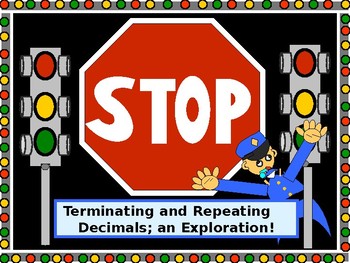Math Lab: Terminating and Repeating Decimals/DISTANCE LEARNING/NO PREP
- PPT
Description
This is a GREAT lab for students to discover the value of patterns in our wonderful world of mathematics!
* In the lesson, students DO discover a relationship between fractions and decimals beginning with NINETEEN FRACTIONS THAT STUDENTS ARE REQUIRED TO DIVIDE THE NUMERATOR BY THE DENOMINATOR ON EACH.
* Students learn the meaning of the terms "terminating" and "repeating" relative to decimals.
* Students learn how and when it is appropriate to use the bar above repeating decimals.
* Using prime factors, students uncover a surprising and practical pattern found in all terminating decimals.
* At the conclusion of the lesson, students have an opportunity to reflect on what they have learned.
As a teacher, I adore presenting this activity to my students!
Please share my enthusiasm for this Math Lab!!!
Happy teaching!





